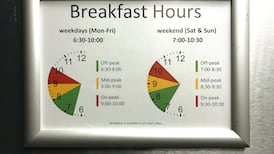The Oireachtas Committee on Health is due to question the National Paediatric Hospital Development Board today about cost overruns at the planned new National Children’s Hospital.
Last December, Taoiseach Leo Varadkar listed in the Dáil 11 sources for the €450 million cost overrun in 2018 at the new children’s hospital. The overrun brings the current estimate of the cost of the hospital to €1.433 billion compared with €650 million in August 2015.
It is an increase of more than 120 per cent in three years. The components of the €450 million overrun during 2018 are as follows:
€21 million for additional or more costly sanitary fittings, theatre lights and gas outlets;
€94 million for drainage pipes, air vents, glazing, etc;
€27 million for extra fire sprinklers and fire protection post-Grenfell;
€20 million for omissions in stage-one design (eg cable supports, firestop detail, pipe cladding);
€48 million for the loss of targeted savings;
€90 million for the extension of construction programme by nine months;
€22 million for contractor claims;
€13 million for other construction works;
€36 million for additional staff, office, insurances, procurement, etc, costs;
€16 million for equipment;
€48 million for VAT;
€43 million of items not included above.
Inflation
These increases cannot be explained by inflation. The Central Statistics Office wholesale price index for capital goods in building and construction in November 2018 increased by 6.2 per cent between 2015 and 2018. The increases in items making up the index during the period ranged from between 1 per cent for ready-mix cement to 7.5 per cent for lighting equipment. Glass prices fell by 3.8 per cent.
Many of the items cited by the Taoiseach in the Dáil overlap the CSO categories but no CSO categories show the price inflation claimed by the proponents of the hospital project.
The price increases must therefore be accounted for by failures to accurately specify the prices and quantities of things such as sanitary fittings, theatre lights, gas outlets, drainage pipes, air vents, glazing, fire sprinklers, cable supports, firestop detail and pipe cladding.
There were also cost underprovisions which led to loss of targeted savings, contractor claims, other construction works, additional staff, office, insurance, procurement and equipment costs which increased the cost of the project by a further €122 million.
The VAT underprovision of €48 million also requires explanation. The €90 million extra charge to taxpayers because the project is running nine months behind schedule is bizarre by the standards of most of an open competitive economy.
A similar exercise to the above is required in respect of the earlier increases in the reported cost of the project from €650 million in August 2015 to €1 billion in October 2017.
Some 43 per cent of the €783 million total cost increase is not covered in the figures given to the Dáil by the Taoiseach. The initial escalation from €650 million to €1 billion has yet to be addressed.
Since the initial cost escalation embodied a culture of cost increase of 54 per cent over the original €650 million cost an analysis of this period is crucial to understanding subsequent developments. We need the full picture.
The overrun information supplied by the Taoiseach to the Dáil indicates a cost problem that requires the intervention of the full forensic skills of the Comptroller and Auditor General, the officer under the Constitution responsible for auditing public expenditure. That officer would then report to the Public Accounts Committee.
The many errors in prices and quantities in the transition of the hospital project from €650 million to €1.443 billion bring into focus who should pay for them. Current government policy is that the errors are the responsibility of the taxpayer. This creates the moral hazard problem as we seek to reform public capital spending. A risk-sharing mechanism is required to ensure that those who make serious economic errors bear at least some of the cost and that there are productivity increases as in other sectors.
This case also illustrates again the folly of the statement in the recent National Development Plan that “no change is proposed to long-established arrangements for oversight, monitoring and management of voted exchequer resources”.
Checks and balances
It was a mistake for this Government to abolish the Economic Management Council of Taoiseach, Tánaiste, Minister for Finance and Minister for Public Expenditure and Reform and to abolish the separate post of minister for public expenditure. The checks and balances introduced to deal with the causes of our last recession are being discarded.
The Department of Finance needs to stir itself and become involved in the hospital cost overrun issue. The reform of the Department of Health should also be a priority. It annually overspends its current budget with impunity and is unable to bring capital projects in on budget and on time.
In his account of the 2011-2016 recovery of Ireland from recession Muiris MacCartaigh of Queen’s University Belfast writes as follows: “Speaking on the health sector, one trade unionist reflected, I think that the DPER probably regrets that they never really got into the heart of the health system. A lot of effort is still going into health reorganisation, but it is not clear what this is achieving. So I think that’s the one area that the crisis didn’t fundamentally change. It’s like Churchill’s famous quote about the dreary steeples of Fermanagh and South Tyrone. When it’s all over, health emerges almost exactly as it was.”
Institutions and policies which caused the recession must be reformed. The hospital cost overrun is a vital test case.
Seán Barrett is fellow emeritus at the Department of Economics, TCD








